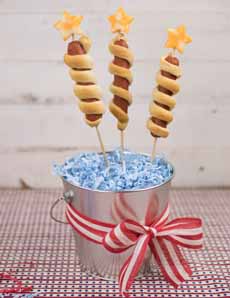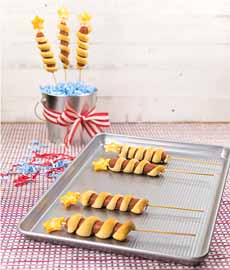JULY 4TH RECIPE: Firecracker Hot Dogs
  Skip the hot dog roll this year, in favor of these fun firecrackers (photos courtesy USA Pan). |
Why stick a hot dog in a roll? These Hot Dog Firecrackers are an easy recipe to serve over 4th of July weekend, fun for all age. You don’t need a roll to hold the ketchup or mustard. You can neatly add them to the “firecracker” via a squeeze bottle or a knife. This recipe came to us from USA Pan, makers of fine bakeware. Prep time is 15 minutes, cook time is 15 minutes. You don’t need a grill: These firecrackers are baked in the oven. Ingredients For 16 Hot Dogs 1. PREHEAT the oven to 350°F. Stick the skewers through the center of the hot dogs until there is an inch and a half of the skewer coming out from the top of each dog. 2. PLACE the crescent dough on flat surface. With a knife, cut ¾ inch thick strips. 3. WRAP each hot dog with a strip of dough, leaving a gap between each spiral. Place the hot dogs on a half sheet pan (see below), leaving a small amount of space between each hot dog. Bake for 15 minutes or until golden brown. While the hot dogs are cooking… 4. CUT stars from the cheese. Assemble on top of the finished hot dogs and serve. |
|
|
THE HISTORY OF SHEET PANS A sheet pan, baking tray or baking sheet is a flat, rectangular metal pan used in an oven. It is typically used for baking bread rolls, pastries and flat products such as cookies, sheet cakes, swiss rolls and pizzas. The most basic sheet pan is literally a sheet of metal, hence the name. If you have a cookie sheet with no continuous lip around the edges, you have a sheet pan. One or two edges are rolled to enable easy handling in and out of the oven. The open sides allow you to remove the warm cookies without disturbing their shape. Modern sheet pans used in commercial kitchens typically are made of aluminum, with a 1 inch lip around the edge. The Sheet Pan Evolves The next step in the development of the sheet pan was to include a lip on one or more edges, to prevent food from sliding off. Some pans add handles to aid in placing the pan in, and removing it from, the oven. A sheet pan that has a continuous lip around all four sides is also called a jelly roll pan. It can be used to make the flat cake layer used for jelly rolls and roulades with other fillings. Today, there are specialty sheet pans that include a layer of insulation or air (an “air bake pan”), designed to protect delicate food like macarons from burning. Sheet Pan Sizes In the U.S.: Cookie sheets are different from baking pans. Baking pans have rolled edges, and cookie sheets do not. Cookie sheets offer the advantage of a large surface area with no edges to impede removing the baked cookies. But their lack of edges limits their uses: You can bake cookies in a baking pan, but you can’t cook a roast (or anything else that expels juice) on a cookie sheet. Baking pans for roasts, called roasting pans, are deeper, to accommodate the size of the roast plus the juices it emits. |
||